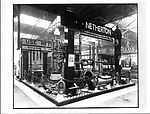 Noah Hingley's exhibition stand
Noah Hingley's exhibition stand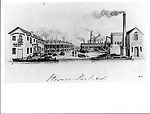 H. Pershouse Parkes Chain Works
H. Pershouse Parkes Chain Works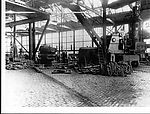 Chain works
Chain works Feel The Heat
Feel The Heat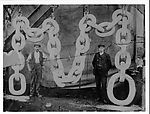 Big chain!
Big chain!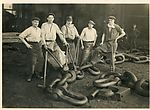 Job Done
Job Done On its way
On its way

For over a century the Black Country was the centre of the chainmaking industry. Offering quality and variety, the Black Country was seen as the main region for chainmaking.
Local high quality iron and coal was the basis for the success of the chainmaking industry. During the late nineteenth century Britain began building up its stock of weapons in response to the German threat. Also during this period shipping lines were building larger passenger ships for the trans-Atlantic route, all of which needed chain.
In 1861 over 2800 people were employed, 500 of them women. By 1911 over 6500 people were employed, 2000 of them women. There were seventy-seven factories in the Cradley area alone, with a total of 235 in Staffordshire and Worcestershire. From 1861 to 1911 the proportion of women working in the industry had risen from 6% to 32%, because they switched from nailmaking to chain.
In 1866 it was reckoned that 50,000 tons of chains and cables were being produced annually, plus another 10,000 tons for agricultural use. Ninety per cent of the chain made in Britain was made in the Black Country in an area of only three square miles around Netherton and Cradley.
Quality was important to the success of the industry. Wrought iron improves the more it is rolled, so chain which was used where safety mattered, was rolled three times to produce “Best Best Chain”. The U.K. was the world’s leading producer of wrought iron, and the quality of the wrought iron chain produced in the Black Country was famous worldwide. A typical manufacturer would offer over 200 different types of chain for a wide range of purposes.
Although people employed in the smaller factories and the domestic workshops had a hard life, the larger factories were known for being caring employers. In 1906 laws were made to protect workers, but firms like N.Hingley and Sons Ltd. did not see the need, as they had already provided secure employment and a fair wage.
Rollover the captions in the box to see the available images in thumbnail format, click the caption to see the full-size image
| Reference: | 667 |
| Keywords: | |
| Archive Ref: | |
| Updated: | Tue 22 May 2007 - 1 |
| Interpretation written by | Louis Howe |
| Author's organisation | Curatorial |
| Organisation's website |